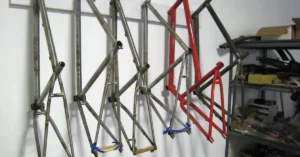Ever hear that clicking sound when you coast on your bike? That’s the freewheel or freehub at work, allowing you to rest your legs while the wheels keep rolling. But what’s the difference between freewheel and freehub?
Despite their similar names and functions, freewheels and freehubs operate in distinct ways. That said, let’s dig deeper into how freewheels and freehubs work, their key differences, and how to identify which one is more suitable for your needs.
Table of Contents
ToggleDifference Between Freewheel and Freehub: Overview
| Feature | Freewheel | Freehub |
| Mechanism | Multiple small freehub springs in pawls (for pawl systems). | The ratchet mechanism is located in the hub. |
| Spring Type | Single large spring in the ratchet mechanism. | Multiple small freehub spring in pawls (for pawl systems). |
| Compatibility | Screws onto the hub. Found in older bikes. | Hub contains ratchet. Found in modern bikes. |
| Maintenance | Replace if faulty. You can not overhaul internals easily. | Overhaulable. You can replace bearings and seals conveniently. |
| Installation | Threads onto the rear hub. | The cassette slides onto the freehub body. |
Before we explore the difference between freewheel and freehub in detail, it’s crucial to understand what these bike components are. Here’s a brief introduction:
What is the Freewheel on a Bike?

A bike freewheel is its mechanical component that allows the rear wheel to rotate freely in a single direction. It engages and drives the bike ahead when you pedal it in the opposite direction.
With a freewheel, you can easily coast (ride forward without pedaling) while your bike is in motion. This mechanism comprises a ratchet (a toothed wheel or gear mounted to your bike’s rear hub) and a pawl system (spring-loaded levels that engage the teeth of the ratchet).
When you pedal forward, the pawl catches on the ratchet’s teeth and turns the rear wheel to propel your bike ahead. As you stop pedaling or pedal backward, the pawls would disengage, facilitating the wheel to spin freely without turning the pedals.
Types of Freewheel
Two major types of freewheel exist, including the traditional freewheel hub and the cassette system. Let’s briefly explore them as we proceed toward understanding the difference between freewheel and freehub:
- Traditional Freewheel Hub: In this system, the freewheel mechanism is integrated directly into the rear wheel’s hub. This design is more common in older bicycles as compared to the modern models.
- Cassette System: This system integrates the freewheel mechanism into the rear hub itself. However, there is a separate cassette of gears that slides onto the hub and locks in place. It’s easier to maintain and promotes versatility.
What is the Freehub on a Bike?

Freehub is a key component of a modern bike’s drivetrain, playing an important role in how it functions. Unlike the freewheel mechanism that consists of gear cogs and ratchets in a single unit, the freehub is a more advanced system separating these functions.
When it comes to the structure of a hub freehub, it incorporates the ratchet mechanism into the rear wheel’s hub rather than in the sprocket cluster. Meanwhile, the gear cogs (part of a component called a cassette) slide onto the body of the freehub is secured properly via a locking mechanism.
With this design, you can conveniently replace or modify the cassette without having to disassemble the hub or the wheel. You will usually find this mechanism on mountain and road bikes, thanks to its enhanced efficiency, reliability, and ease of maintenance.
Types of Freehub
There are several types of freehub bodies depending on their compatibility with different cassette and drivetrain manufacturers. These majorly include Shimano, SRAM, Campagnolo, etc.
Since every brand has its own design and spline pattern for the interface between the cassette and the freehub, these are not interchangeable. However, some degree of cross-compatibility might still exist for your convenience.
How To Determine Your Bike Has a Freewheel or Freehub System?
Before you learn about the difference between freewheel and freehub, do not forget to check which mechanism is employed in your bike.
For this, remove your bike’s rear wheel and use a tool that fits the sprocket set. Then, spin the sprockets backward. If the tool moves with the gear rings, it indicates a freehub or cassette system.
If it remains stationary while the gear spins, your bike has a freewheel system.
Difference Between Freewheel and Freehub: 8 Major Pointers
Now that you are aware of both components of a bike, it’s time to dig deeper into the difference between freewheel and freehub. Here are some major ones:
1. Bearing Location
The first and foremost difference between Freewheel and Freehub is in their bearings. The bearings of a freewheel system are situated inside the unit itself, leading to a complicated servicing process.
Due to gear cogs and ratchets, it’s quite challenging to extract and replace the bolts.
Contrarily, a freehub fixing bolt is located within the hub body. This positioning facilitates easier access for servicing, simplifying maintenance or replacement tasks.
It simply means that you won’t have to disassemble the entire gear mechanism for servicing the bearings.
2. Durability
Since a freewheel system incorporates cog and ratchet in a single unit, its structural stiffness is compromised, leading to reduced durability.
This also impacts the mechanism’s power transfer efficiency, particularly when you are driving on harsh routes.
However, a freehub tool gets an edge yet again, thanks to the larger diameter of its body.
This structural advantage not only facilitates better power transfer but also reduces flex under load. And, of course, its enhanced durability is a major plus point.
3. Compatibility
Another difference between freewheel and freehub lies in their compatibility with different gear speeds.
The compatibility of freewheels is usually limited to cassettes with a maximum of seven speeds because of the physical constraints of its design.
Due to this narrower speed range, bikes with freewheel systems may compromise performance and versatility.
A freehub system is a clear winner in this scenario, allowing configurations of up to 11 speeds or even more.
With this, you can choose from a broader selection of gear ratios, depending on your riding style and preferences.
4. Auditory Characteristics
If you prefer quieter coasting, buying a bike with a freehub mechanism is the key. It’s because the freewheel produces a loud and distinct clicking sound compared to the less pronounced noise by FreeHub.
The sound is a result of the mechanical action within the freewheel unit. Many cyclists even prefer it as it serves as an indicator of the bike’s motion.
While the above-mentioned difference between freewheel and freehub are major ones, here are some additional considerations too:
- Weight and Aerodynamics: If you are seeking weight-saving advantages along with aerodynamics, always go for the freehub mechanism. Its composition of lighter materials and refined engineering processes supports this purpose better than the freewheel.
- Installation and Removal: When it comes to installing or removing a cassette from a freehub body, the process is quite straightforward. You just need a cassette lockring tool and a chain whip for this purpose. However, for a freewheel bike part, a specific tool matching the freewheel’s brand and model is needed.
- Cost: Due to their extraordinary benefits, the cost of the freehub may be higher. However, its long-term durability, increased performance, and ease of maintenance easily outweigh this downside.
- Availability: Nowadays, more cyclists prefer freehub systems for their bike’s drivetrain over freewheel. Thus, this widespread adoption makes it easier to find replacement parts in the market.
Is Freewheel or Cassette Better?
The choice of a freewheel and a cassette depends on your personal preferences and cycling needs.
For instance, freewheels are generally more suitable for entry-level bikes, offering lower cost with compatibility for up to 7 speeds.
Contrarily, if you prefer to select from a wider range of gears, then a cassette-based mechanism should be your go-to choice. Moreover, it’s more durable and easy to maintain as well.
Freewheel to Freehub Conversion: A Comprehensive Guide

Now that we have explored the difference between freewheel and freehub, let’s dig deeper into a guide for converting freewheel to freehub:
- Start by evaluating whether your bike can accommodate a freehub mechanism. If yes, choose an appropriate system compatible with the cassette you plan to use. Moreover, it must also fit your bike’s rear hub snuggly.
- Now, use suitable tools to loosen the axle nuts to remove the rear wheel from your bike. Then, with a freewheel remover tool, start unscrewing the freewheel from the hub.
- If your bike’s current hub is not compatible with a freehub, install a new hub. This step may involve rebuilding the wheel with new spokes. Remember to clean the hub thoroughly after installation.
- Finally, attach the freehub body to the hub by aligning the splines properly and securing it in place. Double-check to ensure the freehub spins freely and locks in the correct direction.
- Then, slide the cassette onto the freehub body and make sure the sprockets are in the correct order. Secure the cassette with a locking ring using a chain and a cassette lockring tool. The key is to tighten it to the manufacturer’s specified torque.
- Lastly, reinstall the rear wheel on your bike and align it properly. Don’t forget to adjust the rear derailleur to accommodate the new gear.
- Take a test ride to ensure everything is working smoothly. Make any adjustments if required!
When Do You Replace Your Bike’s Freewheel or Freehub?
Just like every bike component, freewheel and freehub both require maintenance to function smoothly. After learning the difference between freewheel and freehub in detail, we will now explore some signs that signal their requirement for replacement. These include:
- Difficulty in shifting gears
- Unusual noises like grinding or clicking while pedaling
- The chain skips over sprockets
- Freewheel or Freehub has excessive play and does not engage properly
All the above signs indicate wear or damage to the system. Thus, you must get it serviced quickly to ensure your bike’s performance and your safety.
Read More: How to Become a Pro BMX Rider
FAQs
Why are Freehub pawls not engaging?
Freehub pawls may not engage if you haven’t lubricated them properly. This might also occur due to dirt or debris buildup or when there is damage to the pawl structure or internal ratchet mechanism.
To address this, do regular cleaning and lubricate the parts properly. In case of significant wear and tear, get your freehub serviced or replaced.
What kind of freehub oil should I use for my bike?
For Shimano freehub or that by any other manufacturer, always use a lightweight bicycle-specific lubricant. It’s because these are specifically designed for penetrating and lubricating the internal components of the unit without attracting excessive dirt.
Is it a good idea to grease freehub?
While greasing external bearings and parts of the hub is recommended for smooth operation, you should never do this for the inside unit. Grease can inhibit the engagement of pawls due to its thick consistency.
What should I do to address loose freehub?
In case a freehub body is loose, you must tighten it properly with specific tools depending on the hub’s design. It’s usually best to refer to the bike’s manual for guidance or seek assistance from a professional mechanic to ensure proper adjustment and prevent further damage.
What is a freehub seal?
A freehub seal is part of the freehub mechanism on a bicycle, designed to protect its internal components from dirt, debris, and moisture. These include its pawls and ratchet system.
How does a Shimano 5-speed freewheel work?
The Shimano freewheel hub (5-speed) allows the rider to switch between five gears, enabling easier or harder pedaling depending on the terrain.
Wrapping Up
So that was all about the difference between freewheel and freehub. While the choice depends between Freewheel or Freehub on your personal preferences, freehub gets an edge over Freewheel in all aspects. And thus, it’s being preferred widely by cyclists all around the world.
We hope learning the difference between freewheel and freehub in this guide can help you make the right choice. Choose wisely to ride safely!









